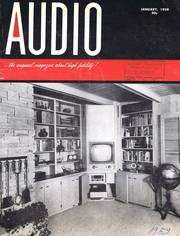Erläuterungen zu diesen US-AUDIO Seiten der 1950er Jahre
Die hier stehenden amerikanischen Artikel aus 1959 (aus der US-AUDIO) sind teilweise sehr gewöhnungsbedürftig, weil sie erstens aus einer längst vergangenen Zeit stammen und zweitens, weil dort in den USA ganz "anders" gedacht wurde als bei uns in Old Germany oder in Europa.
Vergleichbar mit unseren deutschen Hifi-Magazinen etwa ab 1962 ist jedoch, daß auch dieses Audio-Magazin ihre Anzeigen- Kunden und -Leser am Markt oder von anderen Magazinen (be- oder ab- ?) werben mußte. - Weiterhin sind die riesigen Dimensionen des amerikanischen Kontinents mit unseren hier in Europa nicht vergleichbar. - Ein Redaktions-"Trip" von New York nach Los Angeles oder Chicago oder gar in die Wüste nach Las-Vegas zu einer der CES- Audio- "Shows" war - auch mit dem Flugzeug - immer noch eine halbe Weltreise. Und jede Ausstellung oder "Messe" wurde als "Show" deklariert. Und natürlich, in USA musste alles "Show" sein, um beim Publikum einige Aufmerksamkeit zu erzeugen.
.
Die monatliche Kolumne - Editors' REVIEW - das Editorial
"THIRTEENTH YEAR" (das 14. Jahr für AUDIO)
With this issue, Audio becomes a teenager, since it enters its thirteenth year of publication. Starting twelve years ago without any organized industry to represent - and, in fact, with practically no industry at all, organized or not - this magazine started life with no professional publishing experience behind it.
It did have, however, a wholehearted interest in what then was just a hobby for a small group of experimenters who were not satisfied with the sound reproducing equipment which was available to them on the consumer market.
In 1947, you either bought a Brook amplifier or you scrounged around and found some way to get your hands on some broadcast or motion-picture theatre or studio equipment.
But in addition to that whole-hearted interest in sound reproduction of quality, there was one other precept in Audio's favor - the magazine was to be run for the reader, and the material chosen for its pages was selected with considerable thought to make sure that the reader would never be given a "bum steer" about equipment of all types - amplifier circuits, speaker cabinetry, and general audio information.
The Musician's Amplifier, a modification of the British-designed Williamson was one of the first to be copied in both kit and completed form by manufacturers. The loudness control - which, in our opinion, did more to take high fidelity out of the hobbyist's "shack" than any other single advance - first saw light in May, 1948, in these pages. Eemember how the early high fidelity "bug" was always criticized for playing his system too loud? The rear-loaded corner "horn" was first described here - in January and February, 1949 - and that design, too, became a standard.
Langsam begann die Audio-Industrie sich zu formieren
Little by little the industry began to assemble itself. The experimenter with an exceptionally good idea often became a manufacturer, and there are many examples among today's successful companies that started with one man's tinkering and diligent striving for still better sound.
We here at Audio feel that considerable of the credit for the entire high fidelity industry falls on us. We have been extremely fortunate in having loyal and competent contributors whose articles have actually contributed far more to the industry than they have received in return, and it is that kind of loyalty which has made Audio the authority on the technical aspects of high fidelity.
Stolze Leser haben sogar noch die Erstausgabe von Audio 1947
There is another kind of loyalty that is most heartwarming to those of us who attend the hi-fi shows - the subscriber and constant reader who comes up to one or the other of us and tells us proudly that he has every copy from the first issue, or perhaps from the second, whereupon he bemoans the fact that he doesn't have one of the first. We are more than grateful for this loyalty, from reader and contributor alike, for we could not exist without both.
Es gibt etwas Neues, die "TAPE Section"
Continuing in our aim to be of definite help to everyone who wants better sound and more effective operation of his equipment, we are inaugurating a tape section this month.
Under the heading of "The Tape Guide," we will present reliable information to guide you in the purchase and use of tape machines, the techniques of editing, suggested ideas for recording microphone placement, maintenance procedures, and countless tips and aids to the art of tape recording.
While we have lined up a considerable array of material about tape, we know that many readers have independently developed ideas and techniques that would be of interest to others, so we extend a special invitation to those intrepid tape experimenters who "think for themselves."
All contributions will be gratefully received, and all will be paid for. This applies also to photographs of attractive home installations which you believe others would like to see. Not everyone may want to duplicate your home installation, but perhaps you have some particularly attractive solution to a given problem in decoration or component placement and others may glean considerable help from your work.
Hope this doesn't sound as though we are being boastful (angeberisch, protzig), but we are - just a little.
.
AND NOW, THREE-CHANNEL STEREO
Or at least that's what one company has announced in the headlines. But in the fine print it says that there are three speakers - the woofer (probably an enormous 6 x 9" unit) in the center handles the combined low frequencies of both channels, while two separate tweeters handle the highs, one for each channel.
This is a great idea, of course, but it is not new. It works, and it is a good solution, especially where it is difficult to find space for two separate full-range systems. However, we find fault with calling the system "three-channel," and we believe that the manufacturer should reconsider the idea. Three channel means just that - three separate channels from microphone all the way to loudspeaker. It seems that the FTC might take cognizance of this kind of misleading nomenclature.
.
- Anmerkung : Die Bandgerätefirma Ampex hatte bereits 1953 eine 3-Spur Stereomaschine angeboten, mit der in den USA in den Studios die ersten professionellen Stereo-Bandaufnahmen gemacht wurden.
.


